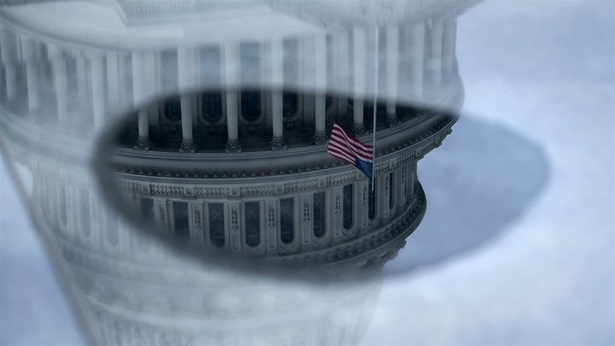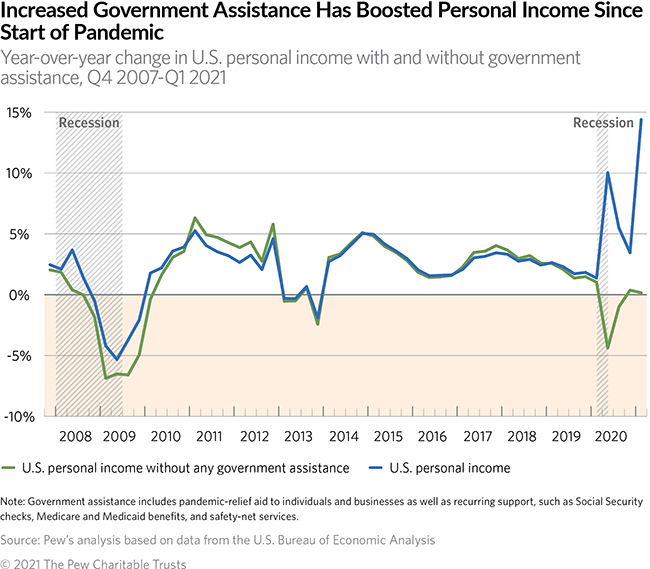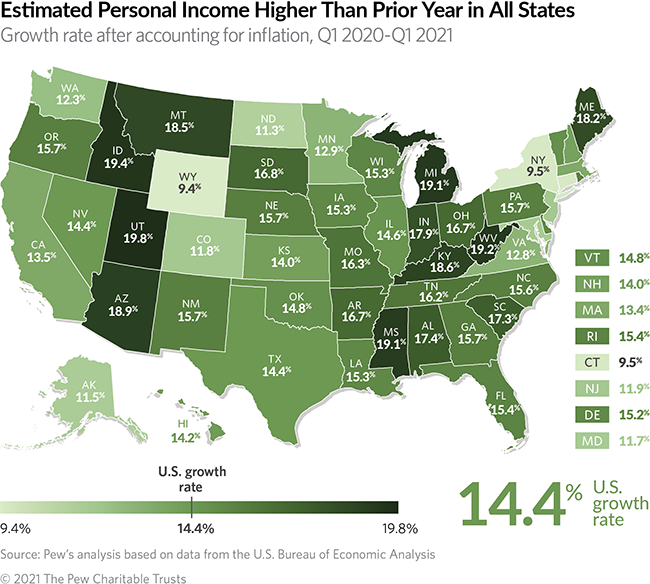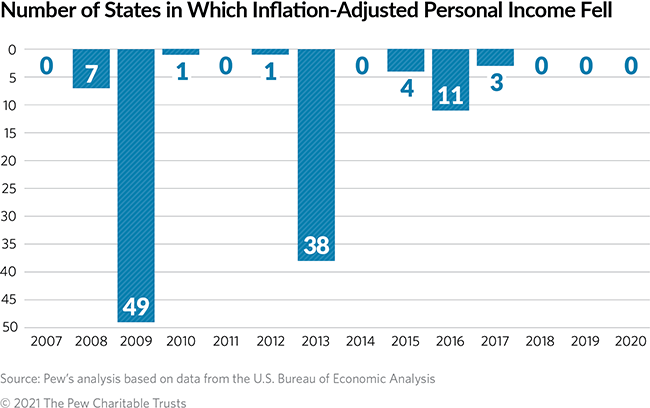States Began 2021 With Record Personal Income Growth
Note: This data has been updated. To see the most recent data and analysis, visit Fiscal 50. On September 2, 2021, a reference in this analysis to the fourth quarter of 2021 was corrected to the first quarter of 2021.
More than half of states recorded their strongest personal income growth ever in the first quarter of 2021 as the economic recovery accelerated. Multiple rounds of pandemic-related government benefits drove year-over-year gains in every state, while earnings—the bulk of personal income—also edged up in most states. The sharp rise in total personal income will be temporary, however, as federal relief payments taper off.
In the first quarter of 2021, nearly all states recorded double-digit growth in total personal income compared with the same period a year earlier, when the abrupt March-April 2020 recession first derailed the economy. Utah (19.8%), Idaho (19.4%), and West Virginia (19.2%) experienced the sharpest increases. Nationally, the sum of residents’ personal income from all sources rose an inflation-adjusted 14.4%, the largest year-over-year growth rate since reporting of this key economic indicator began in 1948.
A spike in government assistance to individual Americans drove the dramatic gains in every state, with total aid more than doubling in Hawaii, Nevada, and Utah, compared with a year prior. Between January and March 2021, one-time payments of up to $600 and $1,400 per qualifying individual, disbursed from two federal economic relief packages, respectively, as well as enhanced unemployment payments, helped millions of Americans weather the crisis. With the extra aid, income received primarily from multiple sources of government assistance—including Social Security, Medicare and Medicaid, safety-net programs, and state unemployment insurance—experienced its second-largest quarterly growth on record.
The injection of federal aid will provide only a temporary boost, however, as pandemic-related assistance is set to decline significantly in the second quarter. More recent national estimates from the U.S. Bureau of Economic Analysis show that U.S. personal income dropped significantly in the second quarter of 2021, compared with the first quarter.
The multiple rounds of federal support for individuals and businesses have led to starkly different results so far than were seen during the Great Recession, when total personal income fell nationally, including in every state. Thanks to the unprecedented temporary government aid, states largely avoided sharp declines in personal income in 2020 after COVID-19 left millions unemployed. In the first quarter of 2021, less than a year after the latest recession officially ended, total personal income in every state exceeded, at least temporarily, its pre-pandemic level, after accounting for inflation. In contrast, it took five years from the end of the Great Recession for the last state—Nevada—to recover to its pre-recession personal income level.
Earnings climbed in most states
The portion of personal income from earnings—which includes wages from work, extra compensation such as employer-sponsored health benefits, and business profits—also increased, although by far less than total government assistance. Earnings were $177 billion higher in the first quarter of 2021 than a year earlier, after adjusting for inflation, compared with a $2.8 trillion increase in income from all sources of government assistance. Earnings ticked up for the third consecutive quarter and are above pre-pandemic levels after plummeting in the early months of 2020. All but 10 states experienced year-over-year gains.
Utah stands out because it benefited from not only the sharpest increase in government assistance compared with 2020’s first quarter (120.4%), but also the top aggregate earnings growth (8.2%) of any state. As a result, it was one of 31 states in which total personal income would have grown over the year even without public assistance. Major contributions to the state's gains in earnings came from jobs in finance and insurance, retail, and professional and technical services, such as lawyers, accountants, and engineers. Similarly, South Dakota, where earnings rose 6.3% from a year earlier, experienced strong growth in health care and social assistance. By comparison, Hawaii experienced the steepest decline in earnings (-6.8%), largely resulting from earnings losses in accommodation and food services as the state’s tourism sector has not yet recovered.
State personal income—a measure used to assess economic trends—matters to state governments because tax revenue and spending demands may rise or fall along with residents’ incomes. It sums up all the money that residents receive from work, certain investments, income from owning a business and property, and government assistance, including the extra federal aid provided in response to the pandemic, as well as benefits from employers or the government. Other measures should be used to approximate income growth for individuals, such as state personal income per capita or household income.
Several issues influence state personal income, many of which are beyond policymakers’ immediate control. Some of the more critical factors include national and global economic conditions, business cycles for a state’s major industries, demographic trends, and investments made over decades.
State highlights over the past year
Temporary government assistance soared in 2021 after the passage of two additional federal relief bills. A comparison of estimated inflation-adjusted state personal income in the first quarter of 2021 with the first quarter of 2020, which included the first month of the COVID-19 recession, shows:
- All states recorded increases in total personal income, but 27 experienced their strongest year-over-year growth on record.
- After Utah, Idaho, and West Virginia, the sharpest overall gains were in Michigan and Mississippi (both 19.1%), while the smallest increases were in Wyoming (9.4%) and Connecticut and New York (both 9.5%).
- States would not have enjoyed such growth if not for government assistance, which ballooned thanks to the influx of federal pandemic aid. In fact, 19 states would have experienced declines in total personal income if all sources of government assistance were excluded, although more than half of those would have incurred only slight declines of less than 1%.
- Excluding government assistance, the top personal income growth—based on earnings, plus dividends, interest, and rent—occurred in Utah (4.9%), South Dakota (3.4%), and Arizona and Idaho (both 3.1%).
- Compared with a year earlier, increases in all sources of government assistance to state residents ranged from 65% in West Virginia to about 120% in Hawaii and Utah.
- Most states also benefited from gains in earnings from work, led by Utah (8.2%), South Dakota (6.3%), Idaho (5.7%), Montana (5.4%), and Arizona (5.3%).
- Earnings still fell in 10 states, however: Hawaii (-6.8%), Wyoming (-3.7%), Nevada (-3.3%), New Mexico (-3.2%), New York (-2.3%), Oklahoma (-2.2%), North Dakota (-1.9%), New Jersey (-0.9%), Alaska (-0.6%), and Louisiana (-0.2%).
Results for the first quarter of 2021 are based on estimates and are subject to revision, as are Pew’s rankings of growth rates for state personal income.
Download the data to see states’ growth rates for total earnings and government transfer payments.
States recovered unevenly from the Great Recession
States entered the new recession from vastly different starting points in terms of the personal income growth they experienced during the longest economic recovery in U.S. history. After the Great Recession, inflation-adjusted personal income eventually bounced back in all states, but at different paces. From the end of 2007 (when the economy peaked before the Great Recession) through the fourth quarter of 2019—the last quarter before the pandemic started to derail the economy—Utah and North Dakota led all states with long-term compound annual growth rates equivalent to 3.4% and 3.3%, respectively, followed by a group of mostly Western states. Connecticut and Mississippi lagged all other states with pre-pandemic growth rates equivalent to 0.9% a year, less than half of the U.S. rate of 2%. These compound annual growth rates represent how much each state’s personal income would have increased had it grown at a steady pace. Although personal income does not actually change at a consistent rate, instead falling in some quarters and rising in others, the measurement provides a uniform way to compare states and track their economic trends.
What is personal income?
Personal income sums up residents’ paychecks, Social Security benefits, employers’ contributions to retirement plans and health insurance, income from rent and other property, and benefits from public assistance programs such as Medicare and Medicaid, among other items. Personal income excludes realized or unrealized capital gains, such as those from stock market investments.
Federal officials use state personal income to determine how to allocate support to states for certain programs, including Medicaid. State governments use personal income statistics to project tax revenue for budget planning, set spending limits, and estimate the need for public services.
Growth in personal income should not be interpreted solely as wage growth; wages and salaries account for about half of U.S. personal income. Likewise, growth in total state personal income should not be seen as a measure of how much the income of average residents has changed.
Looking at state gross domestic product, which measures the value of all goods and services produced within a state, would yield different insights on state economies.
Download the data to see state-by-state growth rates for personal income from 2007 through the first quarter of 2021. Visit Pew’s interactive resource Fiscal 50: State Trends and Analysis to sort and analyze data for other indicators of state fiscal health.
Analysis by Barb Rosewicz, Mike Maciag, and Joe Fleming.


America’s Overdose Crisis
Sign up for our five-email course explaining the overdose crisis in America, the state of treatment access, and ways to improve care
Sign up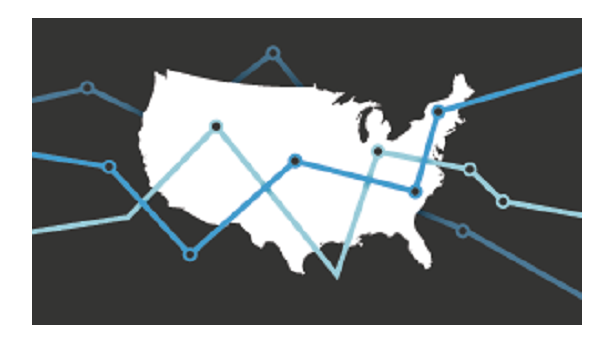
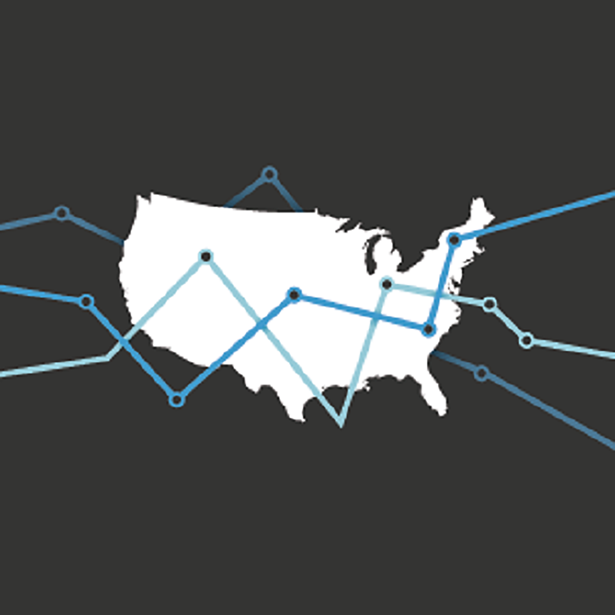
Fiscal 50: State Trends and Analysis
